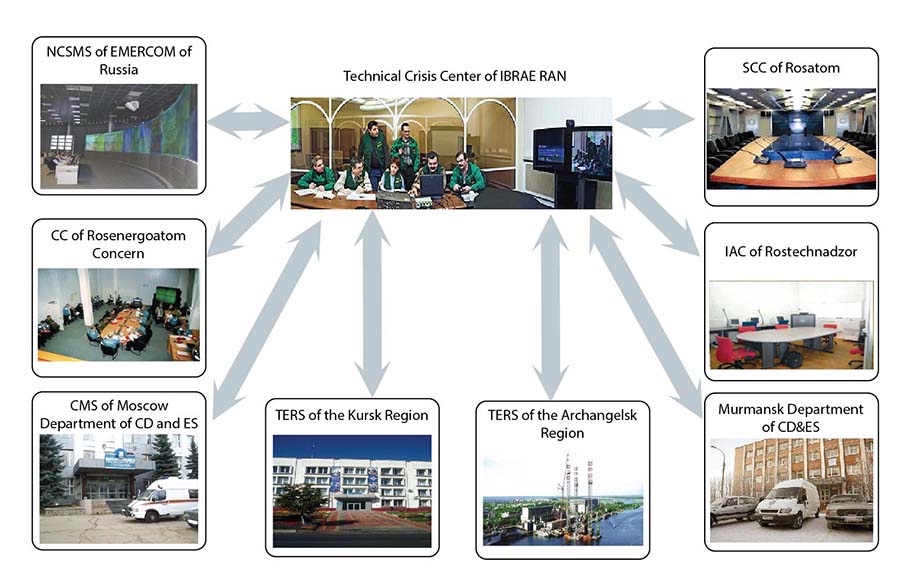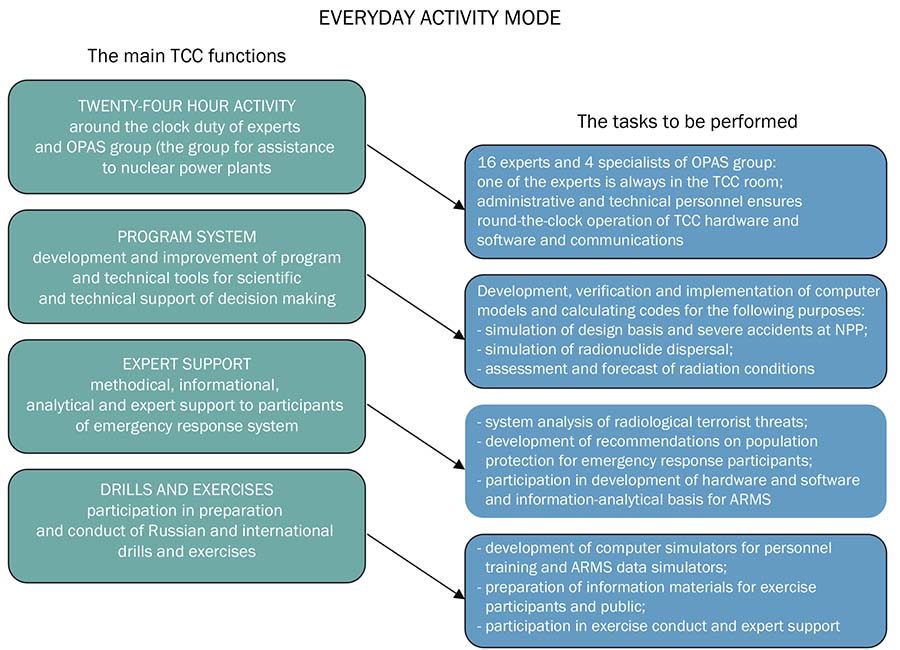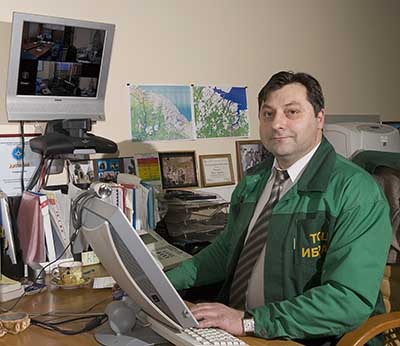| Русский / English |
|

|
NUCLEAR SAFETY INSTITUTE OF THE
RUSSIAN ACADEMY OF SCIENCES
|
TECHNICAL CRISIS CENTER OF NUCLEAR SAFETY INSTITUTE (IBRAE RAN)

At present, all over the world the problems of radiation emergency response are addressed through establishment of the specialized crisis centers. In Russia, this concept was adopted about twenty years ago, and the first operating organizations were established in 1987 shortly after the Chernobyl accident.
In 1992, a laboratory was established in the Division of Radiation Safety and Radiation Risk of IBRAE RAN for carrying out the researches in the field of scientific and technical support of emergency response. In 1996, the laboratory was firstly reformed into the Center of Technical Support to the Crisis Center of "Rosenergoatom", and then, in 1999, into the Technical Crisis Centre (TCC) of IBRAE RAN. To date, TCC is one of the key participants of the emergency response system of Russia. Within the framework of the relevant agreements, it renders a comprehensive scientific, technical, expert and informational support to the federal and regional authorities, industry and institutional crisis centers (National Emergency Management Center of EMERCOM of Russia, SCC of Rosatom, CC of "Rosenergoatom", Moscow Civil Defense Department) in forecasting of radiation conditions, assessment of risks for the population and the environment, mitigation of social and economic damage in the event of radiation emergency.
In the structure of IBRAE RAN, the TechnicalCrisis Center is a division for implementation of the results of fundamental and applied research in the field of nuclear, radiation and environmental safety. First of all we are talking about calculating models and codes that are designed to simulate the physical processes associated with design basis and beyond design basis accidents (including severe) in nuclear reactors of various types, as well as to simulate the spread of radioactive substances in the environment and assess the doses for population. These software tools are the basis of program-technical system of TCC IBRAE RAN which provides the scientific and technical support of emergency response and protection of population and environment in radiation emergencies.
The top priority task of TCC IBRAE RAN is assessment of release consequences and development of recommendations on population and environment protection in emergencies at nuclear and radiation hazardous facilities. This task is performed in one of three modes: daily activities (with around the clock duty of experts and OPAS group- the group to assist the nuclear power plants), elevated preparedness mode or emergency mode.
TCC STRUCTURE
The structure of TCC IBRAE RAN is optimized in accordance with world experience of crisis centers. TCC includes the expert, information-analytical, administrative and technical groups. TCC experts are the highly qualified scientists and experts in the field of nuclear physics, reactor physics, radiation safety, radioecology, programming and development of information systems, many of them have practical experience in mitigation of radiation accident consequences. The total number of TCC staff is 45 people, including 6 Doctors of Sciences, 11 PhD, 20 experts to provide round the clock duty.
TCC IBRAE RAN is organized into four working groups:
Administrative and technical group (ATG), 8 people;
Information and analytical group (IAG) 10 people;
Expert Group (EG) 20 people;
Technical Group (TG) 7 people.
ATG, IAG and TG are the permanent groups of TCC organizational, informational and technical support, EG functions during exercises, drills or in emergency situations.
TCC ATG functions:
- coordination of all TCC activities;
- organizational support of TCC in the modes of daily activity and emergency situations;
- warning and assembly of TCC personnel;
- guidelines on assembly of the full TCC staff (by a decision of the TCC head or IBRAE management) in accordance with operation mode and procedures of notification, assembly and involvement of pre-defined additional forces and resources from IBRAE reserves;
- information interaction with other organizations participating in emergency response;
- participation in preparation of materials for the main TCC activities;
- long-term planning of the measures to protect the population and territories in emergencies.
TCC IAG functions:
- daily maintaining of operability of TCC software;
- improvement of methodical, information, hardware and software tools and maintenance of TCC software and hardware;
- information and analytical support of TCC EG in exercises and emergencies;
- preparation of information and analytical materials.
TCC EG functions:
- analysis and correction of the characteristics of contamination source;
- analysis and correction of the levels of radioactive contamination of environment and exposure doses for population;
- analysis of radiological situation and making the recommendations for population protection and other measures aimed at mitigation of accident consequences;
- interaction with the experts of crisis and support centers of the agencies and organizations;
- participation in preparation of information and guidance materials for the population within the area of emergency.
TCC TG functions:
- maintaining of operability of TCC equipment;
- implementation of measures for development of TCC technical capabilities, including innovations;
- technical support during the exercises or emergencies.
Equipment of TCC IBRAE RAN
TCC equipment includes hardware needed to successfully meet the challenges of scientific and technical support to emergency response participants:
- up-to-date automated workstations for personnel;
- video conferencing system and satellite communications;
- equipment for audio and video presentations;
- servers and communication equipment;
- cluster computing installation of IBRAE RAN for resource-intensive computations;
- uninterrupted power supply system and diesel generator;
- dosimetric equipment.

Interaction of TCC IBRAE RAN with the territorial emergency response systems (TERS), industry and departmental crisis centers.
Functioning modes
TCC IBRAE RAN operates twenty-four-hour.
Depending on the situation TCC IBRAE operates in three modes:
- Everyday activity mode;
- High preparedness mode (“emergency preparedness”);
- Emergency situation mode.
In the everyday activity mode, TCC ATG and TCC IAG carried out work in accordance with their objectives. In this mode, the members of EG TCC should be (in accordance with the schedule of duty) within reach of TCC notification scheme and participate in:
- scientific and methodological support of research and development work in the field of emergency response, nuclear and radiation safety, including the development of radiation accident scenarios and emergency exercises;
- development of TCC software and hardware;
- training of personnel in the field of population and territory protection in radiation emergencies;
- preparation of information and analytic materials.
In high preparedness mode, TCC IBRAE RAN should organize the assembly of personnel to check the readiness of computer systems and communication systems. If the situation at the facility passed into an emergency in a time less than TCC deployment, the TCC performs these functions in emergency situation mode. After bringing the resources into a state of readiness, TCC should start to render scientific and technical support in accordance with the received requests and data.


Experience of the experts
The experts and specialists of TCC IBRAE RAN have wide experience in mitigation of the consequences of radiation accidents and incidents. Even before establishment of IBRAE, many of them were included in the Chernobyl expert group under the leadership of L.A. Bolshov. This activity was followed by work on assessment and prediction of radiation conditions at the site and in the observation area of Armenian NPP after the Spitak devastating earthquake in 1988. In October 1999, express analysis of possible evolution of beyond design basis accident at the nuclear fuel plant in Tokaimura was conducted at TCC IBRAE RAN upon request of the Japanese Embassy in Russia; and at the request of Minatom of Russia, analysis of the impact of the radiation incident at the South Korean Volsung-3 NPP was carried out and recommendations were made to minimize the consequences of these accidents. In their subsequent work, the TCC experts provide scientific and technical support to the actions on localization of all more or less serious radiation incidents both in Russia and abroad.



 |
IBRAE RAN © 2013-2025 | Site map | Feedback |